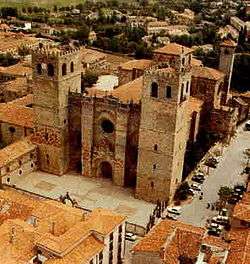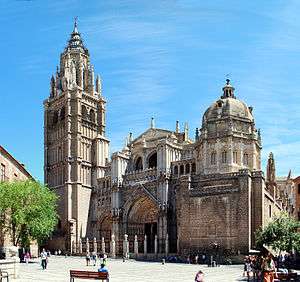Sigüenza Cathedral
| Cathedral of Santa María de Sigüenza | |
|---|---|
|
Native name Spanish: Catedral de Santa María de Sigüenza | |
 | |
| Location | Sigüenza, Spain |
| Coordinates | 41°04′06″N 2°38′29″W / 41.068411°N 2.641267°WCoordinates: 41°04′06″N 2°38′29″W / 41.068411°N 2.641267°W |
| Governing body | Roman Catholic Church |
| Official name: Catedral de Santa María de Sigüenza | |
| Type | Non-movable |
| Criteria | Monument |
| Designated | 1931 |
| Reference no. | RI-51-0000599 |
 Location of Cathedral of Santa María de Sigüenza in Spain | |
The Cathedral of Sigüenza (Catedral de Santa María de Sigüenza) is the seat of the bishop of Sigüenza, in Castile-La Mancha, Spain. It was declared Bien de Interés Cultural in 1931.
It is built in Romanesque and Gothic style.
It is the seat of the Roman Catholic Diocese of Sigüenza-Guadalajara.
The cathedral has its origin in 1121 when Bishop Don Bernardo de Agén (1121–1152) was named bishop by Bernard de Sedirac, Archbishop of Toledo, with the objective of reducing the influence of the bishop of Osma, at the time of the reign of Doña Urraca, daughter of Alfonso VI. Don Bernardo conquered the city 1124. In 1138 Alfonso VII donated land, and in 1144 Don Bernardo founded the cathedral, possibly on the foundations of an existing Visigoth or Mozarabic church.
The cathedral is a very large Gothic edifice of ashlar stone, though the lower levels show that it was built onto an earlier Romanesque cathedral. Its façade has three doors, with a railed court in front. At the sides rise two square towers, 164 feet (50 m) high, built at different times, with merlons topped with large balls; these towers are connected by a balustrade which crowns the facade, the work of Bishop Herrera in the eighteenth century. The interior is divided into a nave and two aisles, in Gothic style.
The main choir begins in the transept with a Renaissance altar built by order of Bishop Mateo de Burgos. In the transept is the Chapel of Saint Liberata (Librada), the female patron saint of the city, with a reredos and the relics of the saint, all constructed at the expense of Bishop Fadrique of Portugal, who is buried there.
What is now the Chapel of St. Catherine was dedicated to St. Thomas of Canterbury by the English Bishop Jocelin. The chapel houses the sepulchre of Martín Vázquez de Arce (Martin Vasques de Arze in the spelling of the time). Vázquez died in 1486 during the conquest of Granada and his brother Fernando, bishop of the Canary Islands, ordered a portrait in alabaster where he lies on his side while reading, in one of the finest examples of Spanish funerary art. It contrasts with the recumbent figures of his parents in the same chapel.
The authors of the Spanish Generation of 1898 (Ortega y Gasset) drew attention to this statue naming him el doncel de Sigüenza, "the boy of Sigüenza", but Vázquez left a widow and children. Cardinal Mendoza is interred in the main choir. Beyond the choir proper, which is situated in the centre, there is the altar of Nuestra Señora la Mayor, in black marble from Calatorao and red marble, featuring spiral Solomonic columns.
The main sacristy is also named as "of the heads". It was designed in 1532 by Alonso de Covarrubias and built by Francisco de Baeza and Martín de Vandoma. The portal is Renaissance, Plateresque, of 1573, in stone, the nuttree door has also Plateresque carvings and was damaged by a cat door and the Napoleonic troops. The half cannon vault features 304 big heads, all different, and 2000 smaller ones, hence the nickname of the room.
The ceiling and the vitrals of the cathedral were damaged in the Spanish Civil War, with the reconstruction ending in 1947.
References
| Wikimedia Commons has media related to Cathedral of Santa María de Sigüenza. |
Galery
- Detail of the Tower of Gallo.
- Main altar.
- Altar behind the choir.
- Reredos of St Librada.
- Chapel of the Doncel.
- The sepulchre of Martín Vázquez de Arce, with "el doncel de Sigüenza".
- Crossing.
- Paintings.
